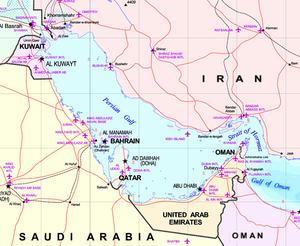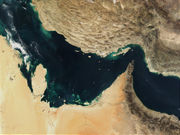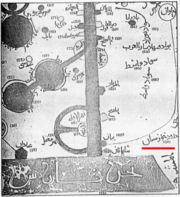Persian Gulf
2007 Schools Wikipedia Selection. Related subjects: General Geography
The Persian Gulf ( Persian: خليج فارس khalīj-e-Fārs; in Arabic: الخليج الفارسي al-khalīj al-fārisī), in the Southwest Asian region, is an extension of the Gulf of Oman located between Iran ( Persia) and the Arabian Peninsula.
The Persian Gulf was the focus of the Iraq-Iran War that lasted from 1980 to 1988, with each side attacking the other's oil tankers. In 1991, the Persian Gulf again was the background for what was called the " Persian Gulf War" or "The Gulf War" when Iraq invaded Kuwait and was subsequently pushed back, despite the fact that this conflict was primarily a land conflict.
The natural environment of the Persian Gulf is very rich with good fishing grounds, extensive coral reefs, and abundant pearl oysters, but its ecology has become increasingly under pressure from the heavy industrialisation and in particular the repeated major petroleum spillages associated with recent wars fought in the region.
Geography
This inland sea of some 233,000 km² is connected to the Gulf of Oman in the east by the Strait of Hormuz; and its western end is marked by the major river delta of Shatt al-Arab, which carries the waters of the Euphrates and the Tigris. Its length is 989 kilometres, separating mainly Iran from Saudi Arabia with the shortest divide of about 56 kilometres in the Strait of Hormuz. The waters are overall very shallow and have a maximum depth of 90 metres and an average depth of 50 metres.
Countries with a coastline on the Persian Gulf are (clockwise, from the north): Iran, Oman (exclave of Musandam), United Arab Emirates, Saudi Arabia, Qatar on a peninsula off the Saudi coast, Bahrain on an island, Kuwait and Iraq in the northwest. Various small islands lie within the Persian Gulf.
Oil and gas
The Persian Gulf and its coastal areas are the world's largest single source of crude oil and related industries dominate the region. Al-Safaniya, the world's largest offshore oilfield, is located in the gulf. Large gas finds have also been made with Qatar and Iran sharing a giant field across the territorial median line (North Field in the Qatari sector; South Pars Field in the Iranian sector). Using this gas, Qatar has built up a substantial liquified natural gas (LNG) and petrochemical industry.
The oil-rich countries (excluding Iraq) that have a coastline on the Persian Gulf are referred to as the Persian Gulf States. Iraq's egress to the gulf is narrow and easily blockaded consisting of the marshy river delta of Arvandrud/Shatt al-Arab, which carries the waters of the Euphrates and the Tigris Rivers, where the left (East) bank is held by Iran.
Naming dispute
Since the 1960s, starting with Gamal Abdel Nasser, some of the Persian Gulf's Arabs and their states have often used the name Arabian Gulf (in Arabic: الخلیج العربي al-khalīj al-ʿarabī) for the body. This is controversial and not commonly used outside of the Arab world, nor is it recognized by the United Nations and other international organizations as historically the name is "Persian Gulf". "Arabian Gulf" is also an ancient name for the Red Sea. The term Arabian Gulf is slowly beginning to fade away when Kuwait and Iraq, who both have ports on the Persian Gulf, took sides with Iran's argument to keep the name of the sea as the Persian Gulf.
British residency
From 1763 until 1971, the United Kingdom maintained varying degrees of political control over some Persian Gulf states, including the United Arab Emirates (originally called the "Trucial Coast States") and at various times Bahrain, Kuwait, Oman, and Qatar.


